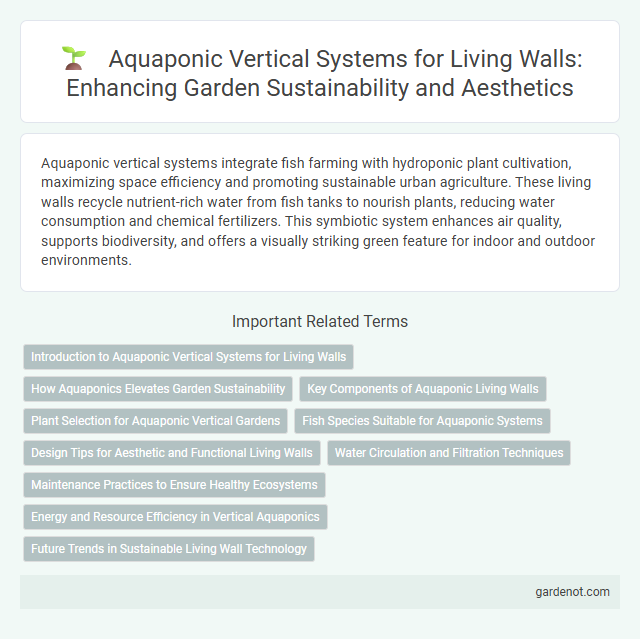Aquaponic vertical systems integrate fish farming with hydroponic plant cultivation, maximizing space efficiency and promoting sustainable urban agriculture. These living walls recycle nutrient-rich water from fish tanks to nourish plants, reducing water consumption and chemical fertilizers. This symbiotic system enhances air quality, supports biodiversity, and offers a visually striking green feature for indoor and outdoor environments.
Introduction to Aquaponic Vertical Systems for Living Walls
Aquaponic vertical systems integrate aquaculture and hydroponics to create efficient living walls that maximize space and resource use. These systems recycle water and nutrients from fish tanks to nourish plants grown vertically, enhancing sustainability and reducing environmental impact. By combining fish cultivation with vertical gardening, aquaponic systems support urban agriculture and improve air quality in indoor and outdoor environments.
How Aquaponics Elevates Garden Sustainability
Aquaponic vertical systems enhance garden sustainability by integrating fish farming with plant cultivation, creating a closed-loop ecosystem that recycles nutrients efficiently. This method reduces water consumption by up to 90% compared to traditional gardening while eliminating the need for chemical fertilizers through natural nutrient cycles from fish waste. The vertical design maximizes limited urban space, allowing for higher crop yields and continuous harvesting throughout the year.
Key Components of Aquaponic Living Walls
Aquaponic vertical systems integrate key components such as plant growing mediums, water reservoirs, and a biofilter to maintain nutrient balance between fish and plants. These living walls utilize a continuous water circulation system that delivers nutrient-rich water from fish tanks to plants, fostering efficient nutrient absorption and waste filtration. Essential elements include pumps, grow beds, fish tanks, and aeration devices, ensuring optimal oxygen levels and promoting sustainable aquaponic ecosystems.
Plant Selection for Aquaponic Vertical Gardens
Choosing plants for aquaponic vertical gardens requires species with adaptable root systems and high nutrient uptake efficiency, such as leafy greens, herbs like basil and mint, and compact fruiting plants like cherry tomatoes. These plants thrive in an environment where fish waste provides essential nutrients, promoting rapid growth and sustainability. Optimal plant selection enhances water filtration and oxygenation, maintaining a balanced aquaponic ecosystem.
Fish Species Suitable for Aquaponic Systems
Tilapia, Koi, and Catfish are among the most suitable fish species for aquaponic vertical systems due to their adaptability to varying water conditions and fast growth rates. These species thrive in high-density environments and efficiently convert feed into biomass, enhancing nutrient availability for plant growth. Choosing resilient fish like these ensures a balanced ecosystem, optimal water quality, and sustainable production in aquaponic living walls.
Design Tips for Aesthetic and Functional Living Walls
In aquaponic vertical systems, selecting a lightweight, durable frame material such as aluminum or powder-coated steel enhances structural stability while supporting plant growth. Incorporate modular planting pockets with integrated drip irrigation to maintain consistent moisture levels and ease plant replacement. Utilize a balanced mix of aquatic species and plants with complementary nutrient and oxygen needs to optimize system efficiency and visual appeal.
Water Circulation and Filtration Techniques
Aquaponic vertical systems utilize advanced water circulation methods that continuously pump nutrient-rich water from fish tanks through plant roots in the living wall, enhancing nutrient absorption and oxygenation. Effective filtration techniques combine mechanical filters to remove solid waste and biofilters hosting beneficial bacteria that convert ammonia into nitrates, promoting a healthy aquatic environment. Maintaining optimal water flow rates and filtration ensures the system's sustainability, preventing clogging and supporting both fish health and plant growth.
Maintenance Practices to Ensure Healthy Ecosystems
Regular monitoring of water quality parameters such as pH, ammonia, nitrites, and nitrates is essential to maintain a balanced aquaponic vertical system. Routine inspection and cleaning of pumps, filters, and grow media prevent clogging and promote optimal oxygenation for plant roots and fish health. Implementing a scheduled feeding plan and removing dead plant material helps reduce waste buildup and supports a thriving aquatic ecosystem within the living wall.
Energy and Resource Efficiency in Vertical Aquaponics
Energy-efficient pumps and LED grow lights reduce power consumption in aquaponic vertical systems, optimizing resource use. Recirculating water systems minimize water waste by continuously cycling nutrient-rich water through plant roots and fish tanks. Integrated design enhances spatial efficiency, enabling higher yields per square meter while conserving energy and water resources.
Future Trends in Sustainable Living Wall Technology
Aquaponic vertical systems integrate aquaculture and hydroponics, optimizing resource efficiency by recycling water and nutrients for sustainable living walls. Future trends focus on advanced sensor technologies and AI-driven automation to monitor plant health and water quality, enhancing system resilience and yield. Innovations in biodegradable materials and modular designs are expected to reduce environmental impact and promote scalability in urban agriculture.
Aquaponic vertical system Infographic

 gardenot.com
gardenot.com